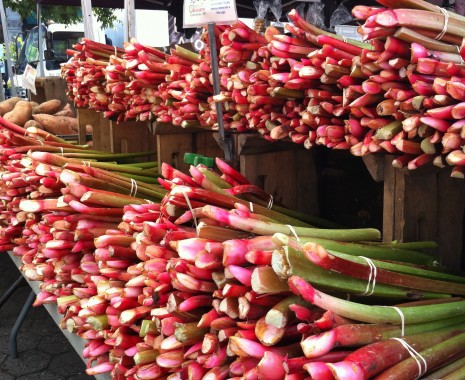A ROSY TIDE OF RHUBARB
I came to rhubarb relatively late in life. It’s not something I grew up with, and a few slices of generically sweet strawberry-rhubarb pie (and one brief encounter with a slithery compote) left me, shall I say, underwhelmed. That is, until about five years ago, when gardening friends from Edinburgh taught me a thing or two about this bracingly tart vegetable (it’s in the same botanical family as sorrel and buckwheat) that’s treated like a fruit.
Rheum rhabarbarum‘s traditional role was medicinal, they explained. The dried root was a popular general tonic for centuries. Native to western China, it was shipped by caravan through Russia to Europe, where it commanded prices higher than those of cinnamon or opium.
The notion of using rhubarb stalks in cooking also came from Asia, but it didn’t catch on in Europe until the early 19th century. According to a 1991 piece by Clifford M. Foust and Dale E. Marshall in Hortscience, a nurseryman named Joseph Myatt, of south London, brought rhubarb to the Covent Garden market in 1808 or 1809. Myatt’s cultivar ‘Victoria,’ introduced in 1837 and prized for its fat, tangy stalks, remains a kitchen-garden favorite in both Britain and the United States.
According to Foust and Marshall, rhubarb’s production in the winter months, when little fresh produce was available, was the result of a happy accident. “The forcing of rhubarb roots was inadvertently discovered in 1815, when earth thrown up by the digging of a ditch in Chelsea Physic Garden covered dormant rhubarb crowns,” they wrote. “Within a few weeks, succulent rhubarb shoots with eye-catching petioles but strangely retarded leaves pushed through the moist, warm mulch in midwinter, long before field rhubarb was due to appear.” Throw in the heavy marketing of produce, especially in London, at that time, and the concurrent rise of sugar production in the Caribbean (making that sweetener more affordable) and British Rhubarb Mania was born.
My friends introduced me to rhubarb fool and rhubarb oatmeal crumble, both of which had undeniable charm. But I wasn’t truly captivated until rhubarb’s tartness, creamed into an applesauce-like purée, was paired with a rich pork roast.
This week’s abundance of rhubarb at the Union Square market put me in mind of that particular dinner party, so I scooped up a bundle, and, shortly thereafter, two thick, well-marbled heritage pork chops. Dinner was under control.
You’ll find the recipe below more of a guideline than anything, and that’s all you really need. Much depends on whether your rhubarb is hothouse- or field-grown and how acidic and/or juicy it is. I basically seasoned to taste, trying to complement the tartness, not trample it.
A few market & kitchen notes: Stalk color can range from red to green; I’d always presumed that the red cultivars were sweeter, but that’s not the case. No matter what variety you find, choose stalks that are crisp and glossy; if they look fibrous, string them like you would celery. In general, field-grown rhubarb is firmer, juicier, and more intensely colored; the hothouse kind is milder and more tender. And because the leaves have a high concentration of oxalic acid, never, ever eat them, whether cooked or raw.
Rhubarb Sauce
I served this with meaty bone-in pork chops, but it would be delicious with duck, too. Next time, I may toss a star anise pod or two into the pot before simmering and see what happens.
About 1 pound rhubarb, trimmed and sliced crosswise
1 to 2 tablespoons sugar, plus more for seasoning
Juice from 1 small orange
Ground cinnamon or allspice
Coarse salt
1. Put the rhubarb into a nonreactive saucepan (i.e., one that’s stainless steel or enameled cast iron), and add the sugar and orange juice. Bring everything to a boil, then reduce to a gentle simmer and cook until the rhubarb is beyond stewed; it must be very soft. Depending on how juicy your orange is (I forgot to measure), you may need to add a little water.
2. Transfer the mixture to a food processor or a blender and purée until it’s the consistency you like. Season to taste with sugar, a pinch of cinnamon or allspice, and salt.
Posted: June 4th, 2013 under cooking, recipes, Union Square Greenmarket.



Comment from Ashley
Time June 5, 2013 at 1:32 pm
I’ve been in the middle of my own personal Rhubarb Mania, so thank you for another wonderful and informative post…and another delicious rhubarb recipe to try!